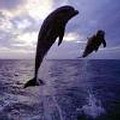 科學家最近發現,棲息在英國多塞特、安格爾西及康瓦耳等保護特區的瓶鼻海豚,會受到水底打樁工程的影響。英國研究顯示,在音源40公里外也可測得的水底打樁及工業噪音,將對海豚的行為、溝通及繁殖產生負面影響。
科學家最近發現,棲息在英國多塞特、安格爾西及康瓦耳等保護特區的瓶鼻海豚,會受到水底打樁工程的影響。英國研究顯示,在音源40公里外也可測得的水底打樁及工業噪音,將對海豚的行為、溝通及繁殖產生負面影響。
水底打樁機用途廣泛,長期以來用來置放碼頭、堤岸、橋樑,近來許多外海鑽油平台工作使用打樁機的機率也很多;而隨著許多國家開始利用強勁的海風發電,在近海水域設置風力渦輪機,打樁機的用途更趨廣泛。
海豚會利用回聲測距來尋找食物和掠食者。牠們送出高頻率的聲波,然後從附近的物體或魚類反彈回來,因而提供海豚所處環境的詳盡地圖。
根據「水與環境管理特許協會」會員大衛(J.A. David)在最新一期《水與環境》期刊中一份科學論文中的紀錄,頻率位於9千赫茲的打樁噪音可以遮蓋過10-15公里內的高強度聲波,40公里內的弱聲波。科學家推測影響遮蓋程度的因素包括:打樁噪音的間歇性、海豚的聽力定位能力、調整聲波強度和頻率的能力、以及聲波信號的構造內容。
大衛建議,工程應該被限制在退潮時分,同時在海豚生產季節停止作業。並且應該在任何活動開始之前劃定一處監控海域,如果海豚進入工作區域,任何海上作業都應該要停止。他呼籲,基於風力發電場的外海工程越來越頻繁,應該針對海洋哺乳生物對工業噪音的反應進行更深入的研究,以緩和這類工程的衝擊。
大衛提議創造一道「氣泡簾幕」(air bubble curtain),以及發送警告信號,讓海豚在工程開始之前有時間離開該區。
科學家協同德州農工大學的「海洋哺乳動物研究計畫」,曾在2000年測試過水底氣泡簾幕的隔音能力。由德州農工大學海洋生物學教授烏爾辛格(Bernd Würsig)領導的研究團隊發現,水底氣泡可以阻擋聲音在水中傳遞──因為氣泡形成一層密度不同的簾幕,且兼具反射及吸收聲波的功能。
烏爾辛格表示,因為氣泡簾幕能在活動區域一公里內有效地降低聲波程度,在實驗期間與工程進行測試應用,都顯示氣泡簾幕確實發揮功能。他建議應該考慮應用這個方法在其他高工業噪音區域,保護其他對聲音敏感的定居性或遷徙性動物。
Pile driving and industrial noise can adversely impact dolphin behavior, communication, and breeding as the noise is detectable up to 40 kilometers (25 miles) from the source, new research reveals. Bottlenose dolphins that live in designated Special Areas of Conservation throughout the United Kingdom, including Dorset, Anglesey and Cornwall, were found to be at significant risk from pile driving noise.
Long used to place docks, bulkheads and bridges, and more recently to site off-shore oil platforms, pile drivers now are being used ever more frequently as countries place wind turbines in off-shore waters to generate electricity with strong coastal winds.
Dolphins use echolocation to find food and locate predators. They send out high frequency vocalizations that bounce off surrounding objects and fish, giving the dolphins a detailed picture of their surroundings.
At 9 kHz, pile driving noise is capable of masking strong vocalizations within 10–15 kilometers and weak vocalizations up to 40 kilometers, J.A. David, a member of the Chartered Institution of Water and Environmental Management, documents in a scientific paper published in the latest issue of "Water and Environment Journal". The impacts of masking are expected to be limited by the intermittent nature of pile driver noise, the dolphin's directional hearing, their ability to adjust vocalization amplitude and frequency, and the structured content of their signals.
Operations should be restricted to low tide and suspended during calving season, David advises. An exclusion zone should be monitored before any activity starts, and marine work should cease if a dolphin enters the work area. David calls for further research into the reactions of marine mammals to industrial noise to help mitigate future effects in relation to the increase in off-shore industry, such as the construction of wind farms.
He proposes creating an air bubble curtain and issuing a ramped warning signal to give dolphins time to leave the area before work commences.
The sound blocking capabilities of an underwater air bubble curtain were tested in 2000 by scientists with the Marine Mammal Research Program at Texas A&M University. A team led by Texas A&M Professor of Marine Biology Bernd Würsig found that underwater bubbles can inhibit sound transmission through water due to density mismatch and concomitant reflection and absorption of sound waves.
Because the bubble curtain effectively lowered sound levels within kilometer of the activity, the experiment and its application during construction represented a success, Wursig said, suggesting that this measure should be considered for other areas with high industrial noises and resident or migrating sound-sensitive animals.






